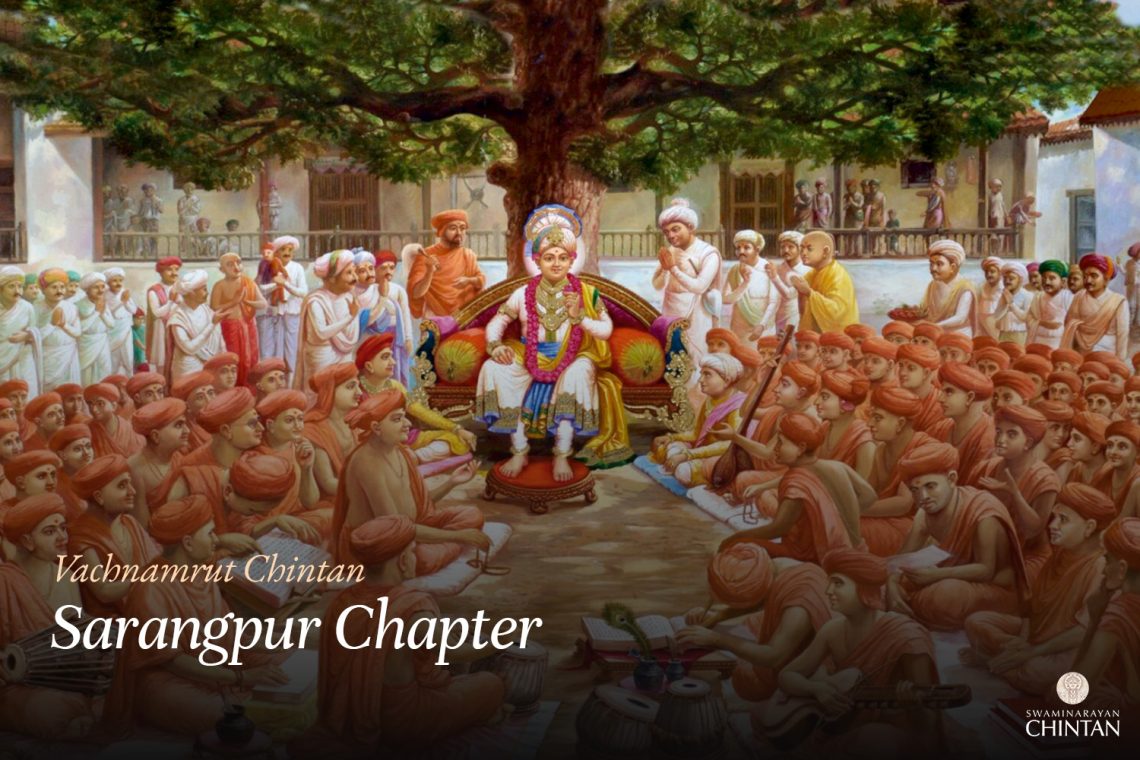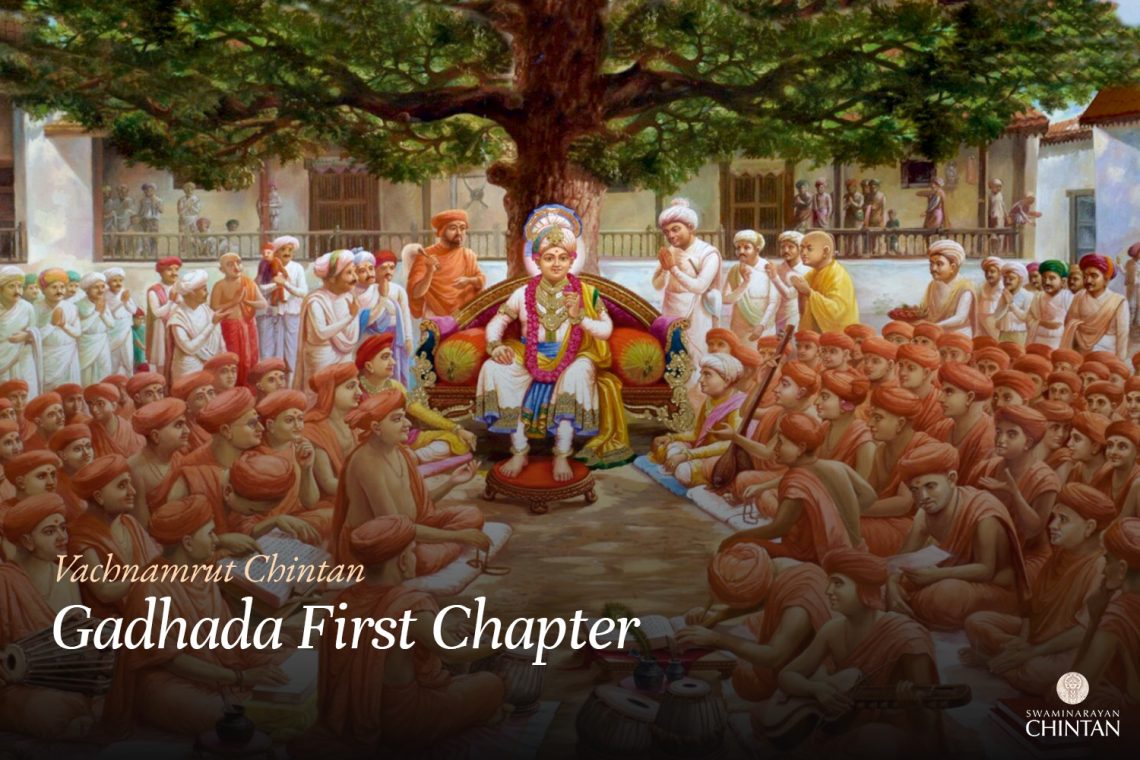Central Insights: Main Points: Commentary: This Vachanamrut is referred to by great saints as the “Vachanamrut of the flood of Kusang” (evil company). Maharaj has explained how a person’s heart and life become a breeding ground for bad habits and weaknesses, what methods the Jiva (soul) uses to protect and…
Browsing CategoryVachanamrut Chintan
S-17 Differences among Muktas; The Branch of a Tamarind Tree
Central Insights: Main Points: Commentary: This Vachanamrut focuses on the differences among the Muktas (liberated souls). Maharaj explains why not all devotees of Bhagwan who are liberated appear to be at the same level. Why are there different stages among them? To clarify this, Maharaj explains that as the perspective…
S-16 Nar-Narayan Dev’s Tap In Badrikashram
Central Insights: Main Points: Commentary: This Vachanamrut discusses the Tap of Narnarayan Rishi. Paramanand Swami asked the question, “Shree Narnarayan Rishi is performing Tap at Badrikashram for the ultimate good and happiness of all human beings in Bharat Khand (Indian subcontinent). Yet, why is it that not all humans follow…
S-15 Obstinate, Mediocre and Mature Gopis
Central Insights: Main Points: Commentary: In this Vachanamrut, Maharaj asked the saints a question. Among the two types of devotees of Bhagwan, one has extreme affection for Bhagwan and cannot remain without His Darshan (divine sight) even for a moment. His love is visibly intense. The other type of devotee…
S-14 Laziness And Infatuation
Central Insights: Main Points: Commentary: In this Vachanamrut, Swayamprakashanand Swami has asked a question: “Bhagwan has said in the Gita that those who attain God’s abode like Vaikunth never return. ‘यद्गत्वा न निवर्तन्ते तद्धाम परमं मम।’ (Yad gatvā na nivartante taddhāma paramam mama) – Gita 15.6. It means “That supreme…
S-13 Losing NishchayAnd Not Losing Nishchay
Central Insights: Main Points: Commentary: In this Vachanamrut, Muktanand Swami posed a question: If someone initially has Nishchay (firm faith / Conviction) in Bhagwan but then loses it, did they ever truly have Nishchay? In response, Swayamprakashanand Swami stated that if someone has attained Nishchay regarding their own soul and…
S-12 Refiection on the Soul
Central Insights: Main Points: Commentary: Nirvikaranand Swami asked, “Which qualities in a Sant are permanent and which are transient?” This question is somewhat complex and can be contemplated from various perspectives. Each perspective will be meaningful to some extent and not considered futile since the concept of a Sant has…
S-11 Personal Endeavour and God’s Grace
Central Insights: Main Points: Commentary: This Vachanamrut is about effort and God’s grace. Maharaj explains the extent to which one’s effort contributes to one’s Salvation and the role of God’s grace. Muktanand Swami asked, “Maharaj, It is said in the scriptures that one achieves his ultimate goal by Purush Prayatna…
S-10 A Physical Perspective versus the Atma’s Perspective; Being Perspective; Beaten by Shoes
Central Insights: Main Points: Commentary: In this Vachanamrut, Maharaj, accompanied by a group of Santo, arrived at the village of Khambhada from Kundal. There, Maharaj addressed the villagers. In this world, there are two types of people: Dharmi and Adharmi. Dharmi people abstain from sins like theft, adultery, slander, and…
S-09 Prevalence of Yugadharm, and What Is Sthan?
Central Insights: Main Points: Commentary: In this Vachanamrut, Muktanand Swami asks a question: “Oh Maharaj! What is the reason for the prevalence of the Yugadharm (properties of different times or eras) in the heart of a person?” Maharaj replies that the reason is the Gunas (the three attributes of Maya).…
S-08 The Nature of Jealousy
Central Insights: Main Points: Commentary: This Vachanamrut is about the nature of jealousy. Chaitanyanand Swami asked the question, “What is the nature of jealousy?” Shreeji Maharaj replied that ego in one’s heart gives rise to jealousy, and the characteristic of jealousy is such that when someone superior is honored, the…
S-07 The Field of Naimisharanya
Central Insights: Main Points: Commentary: In this Vachanamrut, it is mentioned in the first canto of the Bhagwat that Sut Purani narrated the story of Bhagwat to Sanakadik Rishis in Naimisharanya Kshetra. The Sanakadik Rishis had prayed to Brahmaji, requesting a suitable place for their thousand-year-long session. Brahmaji gave them…
S-05 Anvay–Vyatirek
Central Insights: Main Points: Commentary: In this Vachanamrut, Muktanand Swami asked Maharaj a question regarding the powerful single method for eradicating Vasana (worldly desires or impressions). Maharaj replied that Bhakti (devotion) accompanied by the knowledge of God’s greatness is the ultimate means to eradicate all Vasana. Initially, Maharaj explains the…
S-04 Discernment between Atma and Anatma
Central Insights: Main Points: Commentary: This Vachanamrut focuses on the clear identification of Atma and Anatma. Swayamprakashanand Swami asked a question: “Maharaj, how can we clearly understand the distinction between Atma and Anatma so that we do not confuse them as one?” Maharaj replied that whether it is understood through…
S-03 Shravan, Manan, Nididhyas, and Sakshatkar
Central Insights: Main Points: Commentary: In this Vachanamrut, Swayamprakashanand Swami asked Shreeji Maharaj, “Maharaj, one devotee performs direct worship of God with various physical materials, and another performs mental worship with imagined materials. Who is superior among the two?” Shreeji Maharaj replied, “If someone worships God with intense love to…
S-02 Developing Love for God’s Murti
Central Insights: Main Points: Commentary: In this Vachanamrut, Swayamprakashanand Swami asked a question: How does a devotee develop intense love for God’s Murti? This question is quite complex. Love can be of two types: mutual and one-sided. Swami asked a significant question, addressing one-sided love. Maharaj responded by explaining the…
S-01 Characteristics of a Conquered Mind
Central Insights: Main Points: Commentary: In this Vachanamrut, Muktanand Swami posed a question to Maharaj, quoting the shloka from “Maniratnamala“: “जितं जगत् केन मनो हि येन” (jitaṃ jagat kena mano hi yena), meaning “He who conquers his mind conquers the world.” He asked how one can recognize that the mind…
S-06 Two States within Each State; The Four Types of Speech
Central Insights: Main Points: Commentary: In this Vachanamrut, Nityanand Swami asked how the other two Avastha reside within one Avastha. Before answering this question, Shreeji Maharaj clarified that the state in which the Jeev enjoys the objects of senses is called Avastha. Avastha means ‘state or position.’ However, merely stating…
GF-01 Uninterrupted concentration on the Murti of God
Central Insights: Key Points: Commentary The first discourse of this Vachanamrutam discusses the purpose of engaging in an uninterrupted concentration on the transcendent Murti of Supreme God. In any religious text, the basic principle is to initiate with Mangalacharan (benediction prayer). When Mangalacharan also appears at the middle and end…
GF-02 Three Levels Of Vairagya
Central Insights: Clarification about the three kinds of Vairagya. Key Points: Worldly objects cannot control one who is not drawn toward them. Explanation विगतः रागः आसक्ति यस्मात् सः वैराग्यः । रंजयति इति रागः ।।vigataḥ rāgaḥ āsakti yasmāt saḥ vairāgyaḥ | raṃjayati iti rāgaḥ || Things that make us happy create …
GF-03 Remembering The Leelas Of God
Central Insights: Leela (exploits/pastimes) of God should be remembered, and relationships with Santos, Brahmchāries and Satsaṅgis should be developed. Key Points: At the time of death, if one cannot visualise the divine image of God, remembering the Leela Charitras (exploits/pastimes) of the Supreme Lord and recalling the memories of Sadhus,…


